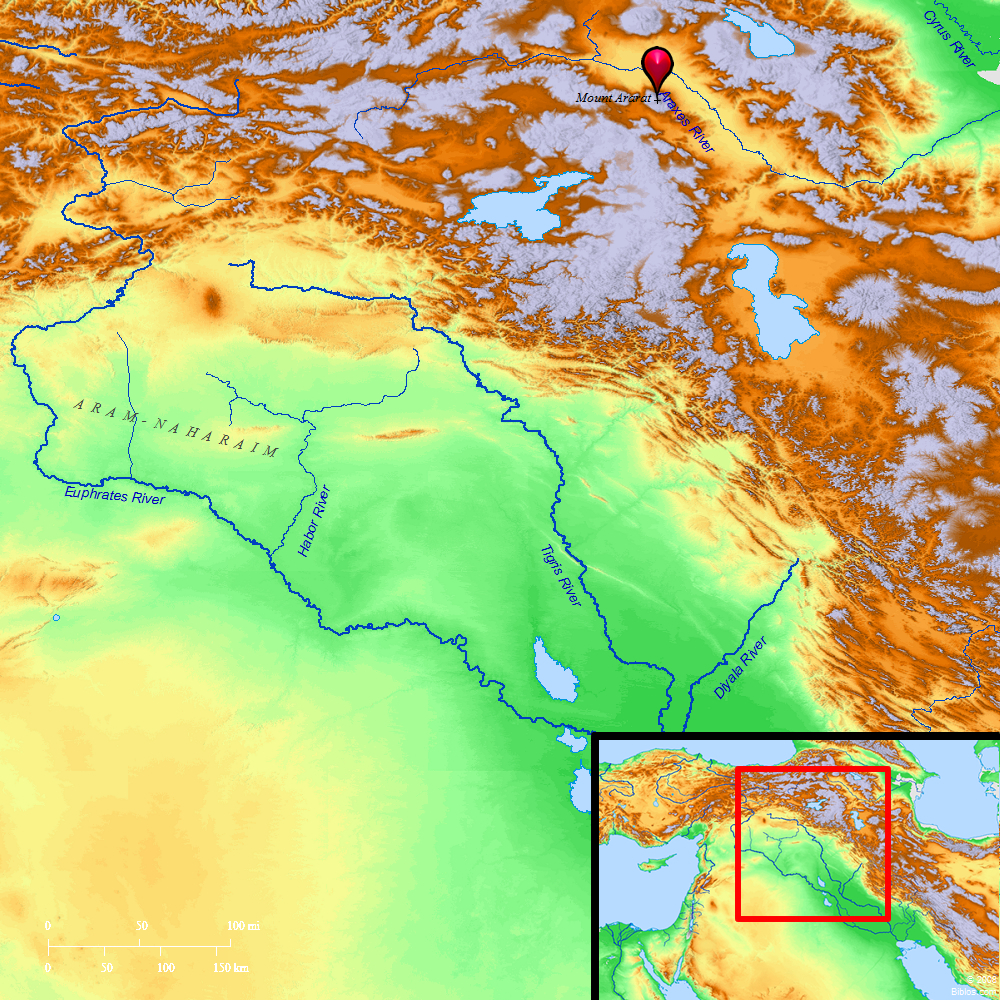Atlas

Mount Ararat and surrounding region
Maps Created using Biblemapper 3.0Additional data from OpenBible.info
You are free to use up to 50 Biblos coprighted maps (small or large) for your website or presentation. Please credit Biblos.com.
Occurrences
Genesis 8:1 God remembered Noah, all the animals, and all the livestock that were with him in the ship; and God made a wind to pass over the earth. The waters subsided.
Genesis 8:4 The ship rested in the seventh month, on the seventeenth day of the month, on Ararat's mountains.
Encyclopedia
ARARATar'-a-rat ('araraT): A mountainous plateau in western Asia from which flow in different directions the Euphrates, the Tigris, the Aras and the Choruk rivers. Its general elevation is 6,000 feet above the sea. Lake Van, which like the Dead Sea has no outlet, is nearly in its center. The Babylonian name was Urartu, the consonants being the same in both words. In 2 Kings 19:37 and Isaiah 37:38 the word is translated in the King James Version Armenia, which correctly represents the region designated. It was to Armenia that the sons of Sennacherib fled. In Jeremiah 51:27 Ararat is associated with Minni and Ashkenaz, which according to the Assyrian monuments lay just to the east of Armenia. In Genesis 8:4 the ark is said to have rested "upon the mountains of Ararat," i.e. in the mountainous region of Armenia, the plural showing that the mountain peak known as Ararat was not referred to. This peak is of volcanic origin and lies outside the general region, rising from the lowlands of the Araxes (Aras) River to a height of 17,000 feet, supported by another peak seven miles distant, 13,000 feet high. It is only in comparatively modern times that the present name has been given to it. The Armenians still call it Massis, but believe, however, that Noah was buried at Nachitchevan near its base.
The original name of the kingdom occupying Armenia was Bianias, which Ptolemy transliterated Byana. Later the "B" was modified into "V" and we have the modern Van, the present capital of the province. The "mountains of Ararat" on which the ark rested were probably those of the Kurdish range which separates Armenia from Mesopotamia and Kurdistan. In the Babylonian account the place is called "the mountain of Nizir" which is east of Assyria. Likewise Berosus locates the place "in the mountain of the Kordyaeans" or Kurds (Ant., I, iii, 6), while the Syriac version has Hardu in Gen. 8:4 instead of Ararat. The Kurds still regard Jebel Judi, a mountain on the boundary between Armenia and Kurdistan, as the place where the ark rested.
This elevated plateau of Armenia has still many attractions, and is eminently suited to have been the center from which the human race spread in all directions. Notwithstanding its high elevation the region is fertile, furnishing abundant pasture, and producing good crops of wheat and barley, while the vine is indigenous. Moreover there are unmistakable indications that in early historic times there was a much more abundant rainfall in all that region than there is now, so that the climate was then better adapted to the wants of primitive man. This is shown by the elevated beaches surrounding lakes Van, Urumiah, and, indeed, all the lakes of central Asia. Great quantities of mammoth bones have been found in these bordering lacustrine deposits corresponding to those found in the glacial and postglacial deposits of Europe and America. It should, also, be remembered that the drying up of the waters of the flood is represented to have been very gradual-it being 170 days from the time the waters began to subside before Noah could disembark. It may have been many centuries before the present conditions were established, the climate, meanwhile, being modified to a corresponding degree by the proximity of vast surrounding bodies of water.
Armenia abounds in inscriptions carved on the rocks, altar stones and columns, but they have been only imperfectly translated. The script is cuneiform and each letter has only a single phonetic character attached to it. But there are introduced a good many borrowed ideographs which have assisted in the decipherment. According to Sayce this cuneiform syllabary was introduced from Assyria after the conquest of Shalmaneser II in the 9th century B.C.
George Frederick Wright




